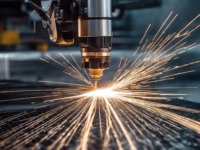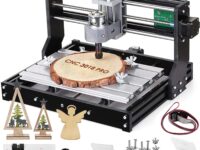G & M Code - Titan Teaches Manual Programming on a CNC Machine.
Titan teaches you how to program a CNC Machine right at the control using G & M codes. Subscribe for daily content and expert ...
Introduction to CNC Code Programming
Overview of CNC Code

CNC (Computer Numerical Control) code programming involves writing instructions for automated machines using a specific language understood by the machine's computer. These codes dictate how the machine should move, cut, or shape materials such as metal or wood with precision and accuracy. By mastering CNC code programming, individuals can create complex designs and produce intricate parts efficiently.
Commonly Used G-codes in CNC Programming
| Benefits | Description |
|---|---|
| Precision | Users can achieve high levels of precision and consistency in their manufactured components. |
| Efficiency | CNC code programming allows for faster production times and reduced waste materials. |
| Automation | Tasks that are repetitive or require intricate details can be automated, increasing productivity. |
| Career Opportunities | Proficiency in CNC code programming opens up opportunities in industries like manufacturing and engineering. |
| G-Code Command | Description“` |
|---|---|
| G00-G01 | Rapid Move/Linear Interpolation |
| G02-G03 | Arc Interpolation/Circular Interpolation |
| G17-G19 | Select Plane(XY/XZ/YZ) |
Benefits of Learning CNC Code Programming
CNC code programming offers numerous benefits like precision, efficiency, automation, and career opportunities in industries such as manufacturing and engineering. These benefits come from the ability to control machine tools and equipment through computer commands, allowing for highly precise and accurate production processes. By programming CNC machines, operators can automate complex tasks and produce high-quality workpieces with minimal errors. This level of automation also helps to increase efficiency in production processes, reducing both time and costs.
Moreover, proficiency in CNC programming opens up various career opportunities in industries that rely on cutting-edge technology, such as manufacturing, aerospace, automotive, and medical device production. Skilled CNC programmers are in high demand and can expect lucrative salaries and job stability in these growing sectors. With the continual advancements in CNC technology, learning CNC programming can be a valuable asset in securing a successful career in the field of engineering and manufacturing.
G-code Basics
Understanding G-code Syntax
G-code is a language used in CNC programming to control the movement and functions of a machine tool. Each command in G-code instructs the machine on how to perform a specific task such as cutting, drilling, or milling. The syntax of G-code consists of letters, numbers, and special characters that define various parameters and actions. Understanding G-code syntax is crucial for accurately communicating instructions to the CNC machine for precise operations.
Commonly Used G-codes in CNC Programming
Some commonly used G-codes in CNC programming include:
G00 – Rapid positioning
G01 – Linear interpolation
G02 – Circular interpolation (clockwise)
G03 – Circular interpolation (counter-clockwise)
G04 – Dwell (pause)
G17 – Select XY plane
G18 – Select XZ plane
G19 – Select YZ plane
G20 – Set units to inches
G21 – Set units to millimeters
G28 – Return to home position
G40 – Cutter radius compensation off
G41 – Cutter radius compensation left
G42 – Cutter radius compensation right
G43 – Tool length offset positive
G44 – Tool length offset negative
G49 – Cancel tool length offset
These are just a few of the many G-codes that can be used in CNC programming to control the movement and actions of the machine.
Introduction to CNC Code Programming
Overview of CNC Code Programming
CNC (Computer Numerical Control) code programming is the process of creating instructions for automated machines using a specific language understood by the machine's computer. These codes precisely guide the machine in movements and material shaping, such as metal or wood cutting. Proficiency in CNC code programming enables individuals to efficiently produce complex designs and intricate parts.
Benefits of Learning CNC Code Programming
CNC code programming provides advantages like precision, efficiency, automation, and promising career prospects within manufacturing and engineering sectors.
CNC Programming Software
Popular CNC Programming Software Tools
When it comes to software tools for CNC programming, popular options include Fusion 360, Mastercam, and SolidWorks CAM.
Features to Consider in CNC Programming Software
Important features to evaluate in CNC programming software include ease of use, compatibility with different machines, simulation capabilities, post-processing support, and technical support availability.
Advanced CNC Programming Concepts
Multiaxis CNC Programming Techniques
Advanced CNC programming concepts, such as multiaxis techniques, involve using machines that can move in multiple directions simultaneously. This allows for more complex and intricate part designs to be manufactured with precision and efficiency, expanding the capabilities of CNC automation further.
Toolpath Optimization in CNC Programming
Toolpath optimization plays a crucial role in CNC programming by strategically planning the movements of cutting tools to minimize machining time and material wastage while ensuring high-quality part production. By optimizing toolpaths, manufacturers can enhance productivity and reduce production costs effectively.
Troubleshooting CNC Code Errors
Identifying and Fixing Common CNC Code Errors
When encountering CNC code errors, operators need to have a keen eye for detail to identify common issues such as syntax errors, incorrect tool offsets, or improper cutting parameters. By closely examining the program code and machine responses, they can pinpoint the root cause of the error and make necessary corrections to ensure smooth production processes. Regular training on common coding mistakes can also help operators sharpen their troubleshooting skills and enhance overall operational efficiency.
Best Practices for Debugging CNC Programs
Effective debugging practices for CNC programs involve systematic testing, simulation, and verification procedures. Operators should conduct thorough tests on small sections of the program before running it on the actual machine to detect potential errors early on. Utilizing software tools for simulation can help visualize tool movements and identify any inconsistencies in the code. Additionally, maintaining detailed documentation of program revisions and changes enables quick identification and resolution of issues during the debugging process, ensuring optimal performance of CNC machines.
CNC Code Simulation and Verification
Importance of CNC Code Simulation
CNC code simulation plays a crucial role in ensuring the flawless operation of machining processes. By simulating the program code on virtual platforms, operators can identify and address potential errors before executing it on the actual machine. This not only prevents costly mistakes but also enhances efficiency by reducing machine downtime caused by code-related issues. Consistent simulation practices help in optimizing tool paths, minimizing material waste, and improving overall production quality.
Tools for CNC Code Verification
Various software tools are available to facilitate CNC code verification and simulation processes. These tools offer features such as real-time visualization of cutting operations, collision detection, and accuracy analysis to validate the program behavior accurately. Operators can leverage these tools to run sophisticated simulations that mimic actual machine operations closely and ensure smooth execution without errors. Investing in reliable verification software can streamline the programming workflow, enhance precision, and boost productivity in manufacturing environments effectively.
Key Takeaways from CNC Code Programming
Key takeaways from CNC code programming include the importance of understanding the syntax and structure of G-codes and M-codes, as well as the ability to interpret and modify existing code to achieve desired outcomes. It is essential to have a strong understanding of the machine tool and workpiece setup, as well as the ability to troubleshoot and debug code when necessary. Additionally, having a comprehensive knowledge of math and geometry is crucial for creating precise and efficient CNC programs. Continuous learning and practice are essential for mastering CNC code programming and consistently producing high-quality machined parts.



















